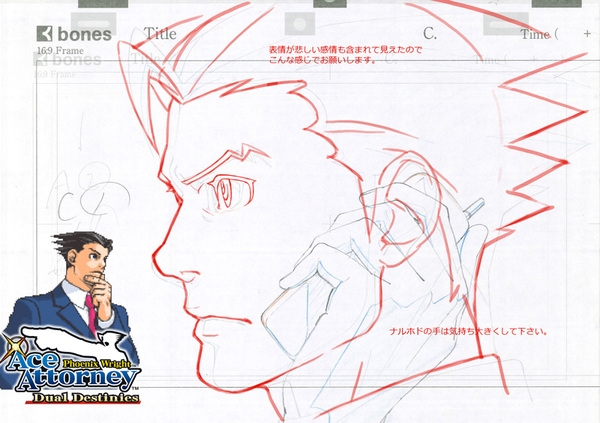
Intro to Japanese Anime Production starring Phoenix Wright
Oct 25, 2013 // Janet Hsu
Hi, hi! Janet here! Have you been counting down the days until the release of Phoenix Wright: Ace Attorney – Dual Destinies ? I know I have! Well, that day has come and to quote Edgeworth: Whoooooooooooooop! The dev team and I can’t wait to read your reactions online and lurk on your tumblr blogs! (Kidding! Kidding! …Or am I?)
This week, we are fortunate enough to have the Game Director Mr. Yasuhiro Seto discuss how the anime cutscenes were put together. This is pretty exciting because this is the first game in the Ace Attorney series to feature such cutscenes. Now, without further ado: Mr. Seto!
Hi everyone! I’m Yasuhiro Seto, the director of Phoenix Wright: Ace Attorney – Dual Destinies. The game will be available in just a few short days, so I’m glad I made it in here before then! So what is it that I do? Well, I’m sort of like Mr. Yamazaki’s backup – I make sure that the team is running smoothly and that everyone is on the same page while Mr. Yamazaki focuses his attention on the game’s scenario.
As those of you who have already played the game in Japanese know, Dual Destinies is unlike any of the previous Ace Attorneys in that this one features a lot of gorgeous anime cutscenes throughout the game! It was a pleasure to be the Anime Director on the dev team side as we worked with the famous animation studio BONES, which produced such great shows as “Eureka Seven: AO”. Needless to say, the anime segments were created with as much care as the game itself, and they seamlessly dovetail into each other. As an example, let’s use the guard next to the staircase that appears in the opening anime as I talk about how we incorporated this new element into the Ace Attorney series.
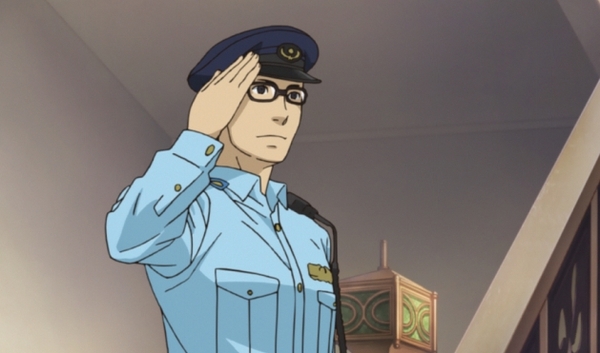
Before any animation work can begin, you must have a script, and it just so happens that I have a copy of the rough script Mr. Yamazaki drafted. Notice that it outlines just the character’s lines and the general backdrop and events for each scene.
 Translated a little on the literal side for your comparing pleasure later – Janet
Translated a little on the literal side for your comparing pleasure later – Janet
As you can see, the descriptions in the section where Athena is first introduced up through the part where she trips and falls are very bare-bones – they barely describe where she is or what she’s doing – and the guard is nowhere to be seen. After Mr. Yamazaki wrote this outline, it was passed on to the Animation Director at BONES, Mr. Kenji Nagasaki, who turned it into a series of storyboards for us. As he was doing thing this, he suggested the idea of having Athena tumble down a flight of stairs instead of simply tripping and falling, and that’s how the idea of the staircase came to be. In addition, he said that we can emphasize just how painful the fall was by adding a guard to the scene and having him interact with her at the end of the scene, and that was how “Mr. Guardman” came into being.
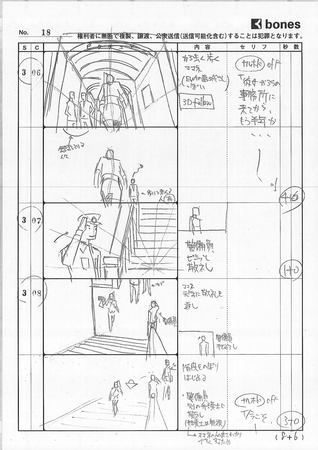
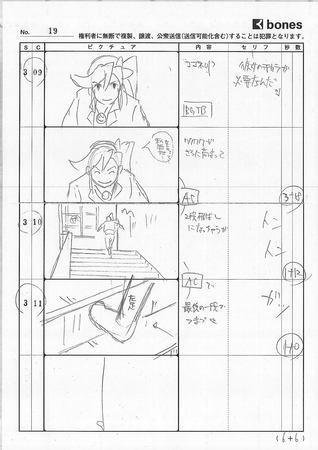
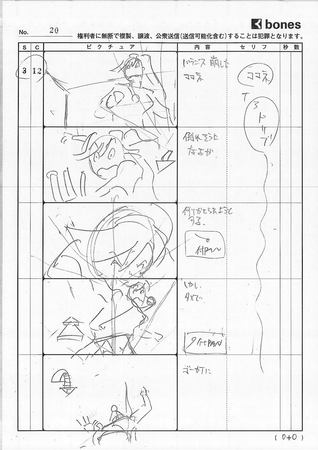

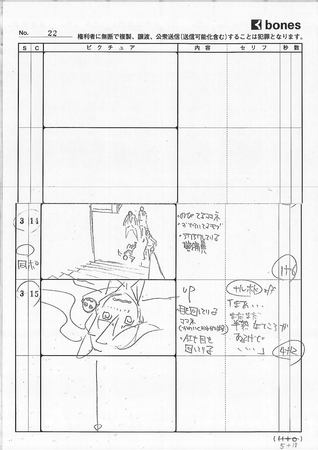
Click to enlarge
In the storyboards above, you can see that Athena returns the guard’s salute before going up the stairs. The guard then turns to salute another, older lawyer who completely ignores him. Mr. Nagasaki’s intention with this short exchange was to convey just how good of a person Athena is at heart, and how naïve she is about the pecking order, among other things, in the world of law. These sorts of details and nuances are decided on at this stage of the production, and once we had finalized the scene, it was time to figure out how we wanted to flesh out the background. In the game, we have the courtrooms and the defendant lobbies, but we’ve never had to show the courthouse’s main hallway and staircase before. Therefore, we had to come up with and decide on a design for these locations that would be used exclusively for the anime cutscenes.
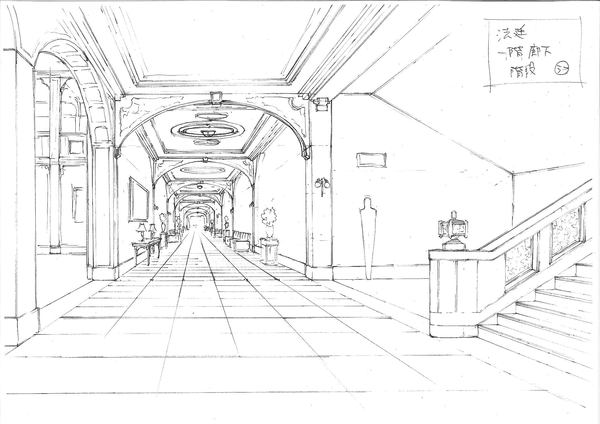 This is the final design of the hallway that BONES created.
This is the final design of the hallway that BONES created.
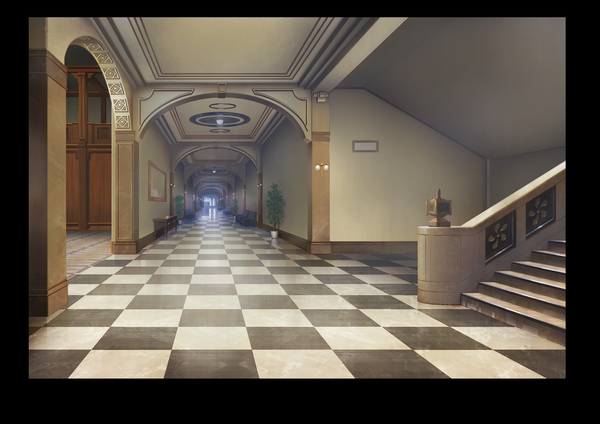 Just by adding color, the background looks a lot more realistic and really brings the line drawing to life!
Just by adding color, the background looks a lot more realistic and really brings the line drawing to life!
Once the scene’s various components were locked down, it was time to finally tackle the next step: layout. Layout is the process by which the animators decide on a number of elements such as the camera angle at key points in the scene and exactly how different movements will play out in the final take. With Dual Destinies, one of the things we really wanted to focus on was the way our characters’ faces would be drawn and animated. We wanted to make sure that they matched up with our in-game models, so our Art Director Mr. Fuse worked extra hard to give detailed feedback on how to bring the anime designs more in line with what’s in the game. (His feedback/re-drawings are in red.)
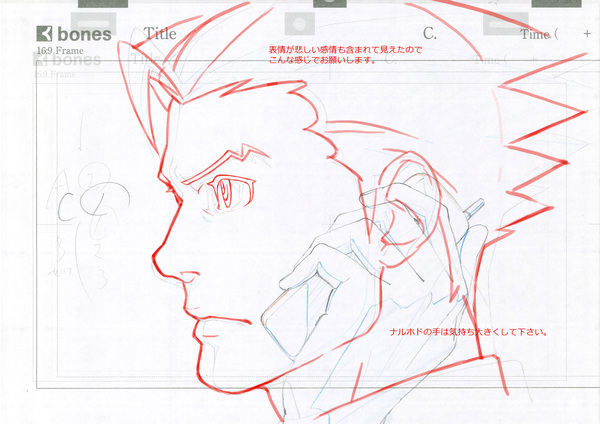
TOP: The original expression in the line drawing had a touch of sadness in it. Please make it more like this.
BOTTOM: Please balance the size of Phoenix’s hand and give it a bit more presence.
 TOP: Please make her look more feminine and have her sit up straight and tall like a news anchor. She’s looking up info about a case, so she should have a more serious expression on her face (maybe elongate her jawline a little?)
TOP: Please make her look more feminine and have her sit up straight and tall like a news anchor. She’s looking up info about a case, so she should have a more serious expression on her face (maybe elongate her jawline a little?)
CENTER: About how she interacts with the holographic display, having her use just one finger here makes it look like she’s afraid to touch it, so maybe have it look like her whole hand is involved somehow and that she feels very comfortable with the display.
With all of the layouts approved, the animators moved on to drawing the key frames. These key frames are the foundation upon which the entire anime segment is built because after the key frames are finalized, the frames in between them will be drawn in a process known as “inbetweening”. These inbetweens are what really transforms the individual key frames into a living, breathing anime. Finally, we reach a point where everything begins to come together. After the anime footage is finished, it is rendered into 3D, and the characters’ voices, background music, sound effects, sound leveling, remixing, and a lot of other complicated procedures are layered on top to create the final anime segment you see in the game.
So what happened to the guard we were talking about who was born during the storyboards stage? Well, actually, he does appear in the game for one brief moment here in the Tokyo Game Show 2012 version of the demo!
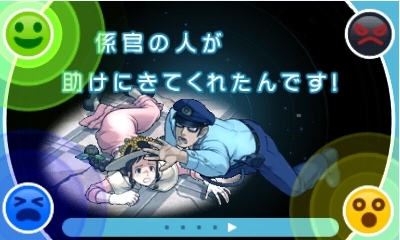 This good-looking fellow in the black-framed glasses!
This good-looking fellow in the black-framed glasses!
So, those of you who were able to play this version, consider yourselves super lucky and hard-core as you got to see the only version where this guard makes an in-game appearance.
We really owe a lot to BONES for their wonderful animation work that helped to flesh out the world of Ace Attorney and gave us another vehicle with which to tell our story. I hope you’ll join me in thanking them for helping us realize one of our dreams for Dual Destinies.
Speaking of thanking people, one of my duties as director – if not my most important duty – was to decide on the overall direction of the game. As with any group of people, every member of our team had their own ideas on how to proceed, but I’d have to say the person with the most influence was the indispensible Mr. Yamazaki. He was everything to everyone as he drew out the very best from those around him. He was one part Scenario Director, one part writer, one part editor, and the perfect engine that drove the game’s production.
In addition to Mr. Yamazaki, I have to thank our Producer, Mr. Eshiro, who also helped to keep us on track. His work as producer ensured that what we were making was something that the players would want. His ability to view the game as a “product” and give us feedback based on that viewpoint was invaluable, although it got a little harrowing on the occasion when a piece of Mr. Eshiro’s business-like advice clashed with Mr. Yamazaki’s creative spirit, and then we the team had to work out a compromise that would please both titans… *sweatdrop*
The clashing of ideas may sound like a bad thing, but it’s just the opposite. In fact, I’d say that the reason Dual Destinies turned out as a great game overall is because everyone on the team raised a variety of ideas and were willing to passionately discuss them at length. But it wasn’t enough to just discuss them – after a while, a final decision always had to be made, and let me tell you, that was no small task. Sometimes, if it was a big decision, it would take me days to decide what to do, but at the end of the day, I believe we’ve made a really great game. I hope you will enjoy playing it as much as we enjoyed making it.
Thank you, Mr. Seto for that wonderful explanation, and I agree – the anime is definitely visually gorgeous! As for teamwork, it’s true that sometimes the best ideas are born of conflict and discussion, but I don’t envy the position you were in!
One thing Mr. Seto touched upon in his description was the voice dubbing, and while Mr. Yamazaki wrote the original lines in Japanese and the anime was drawn to match those lines, adapting the script into English meant taking preexisting lines and working within the time and mouth flaps restraints set by the Japanese. Just to give you an idea how translating/localizing for dubbing differs from translating for text windows or even subtitles/captions, here’s how the final recording script turned out:
 Redacted for spoilers
Redacted for spoilers
Compare that with an earlier, pre-recorded version:
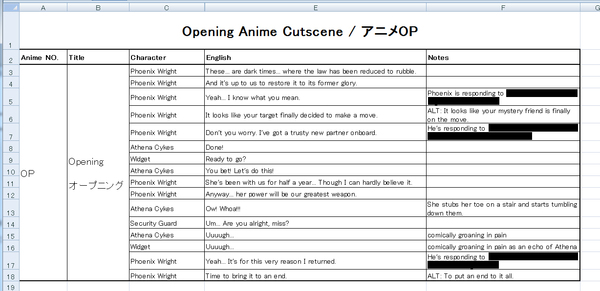
You don’t really want to know who Phoenix was talking to… do you?
While you won’t see that much of a difference in the lines since this is a nearly final version of the script, you’ll see that there are what are known as “ALT takes” in the Notes column. This is one of those differences that I will come back to a little later on.
I touched on this last time in the UI discussion , but when I’m only translating the text, my only constraint is the size of the text window, but with dialogue, the number of factors I have to consider balloons to include things such as:
• The length of the Japanese when it’s spoken
• The inflections in the Japanese that create pauses in the sentence when performed by the voice actor
• The number of mouth flaps in the footage as the characters are talking
• What feels natural and what will roll off the tongue of the English voice actors
• What the lines themselves sound like in English (Are there a lot of consonants in a row? Does that sound too harsh for a soft statement? Will it sound pleasing to the ear? How rhythmical should it be?)
• If a character changes facial expressions mid-sentence (Does the English match that change in timing and tone?)
These are just a sampling of the issues I thought about as I translated the voice script (The Japanese voice recording had not taken place yet when I was translating the English dialogue, by the way, so I really had to use my imagination. Good thing I watch a lot of anime so I was familiar with standard anime conventions, ha ha.). Many people are quick to blame the voice actors if they think a dub is “bad” but I feel that these factors on the translation/script writing side contribute to what makes a dub “good” versus “bad” as well.
As an example, take the lines Athena and Widget say just before Athena stands up from the sofa.
Athena: 「よ-し!」 (Yo–shi!)
Widget: 「イキマスカ!」 (Ikimasuka!)
Athena: 「そろそろ、行きますか!」 (Soro soro, ikimasuka!)
Literally translated, it’s something like this:
Athena: All right!
Widget: Shall we get going?!
Athena: It’s about that time, isn’t it?!
In English, it would sound really odd for her to say that last line so blatantly rhetorically considering she’s replying to Widget and she’s trying to psych herself up, so the first thing was to adapt it to something a little more natural:
Athena: All right!
Widget: Shall we get going?!
Athena: You bet! Let’s go!
That’s a little better, but if you know Japanese, and if you watch the footage, you’ll see that there is only one mouth flap where she says “よーし!” and then there’s the issue of how short and quick Widget’s line is compared to how long it takes Athena to say the line, “そろそろ、行きますか!” in Japanese.
Thinking about what Athena actually means when she says, “よーし!”, she’s actually expressing pleasure at finishing her pre-trial research, so I adapted the line to something a little more fitting. Then, I counted the beats for Widget and Athena’s lines after that, factored in how I wanted these characters to sound as this was the first impression you the players would get of them, and arrived at these final translations:
Athena: Done!
Widget: Ready to go?
Athena: You bet! Let’s do this!
Another example is Phoenix’s last two lines. This is where mouth flaps really came into play, and why there was an ALT line in the pre-recording version of the script.
「‥‥ああ。ぼくは、このときのために戻って来たんだ‥‥」 (…Aa. Boku wa, kono toki no tame ni modotte kitan da…)
「決着をつけるよ」 (Kecchaku wo tsukeru yo)
Literally:
…Yeah, I returned for this moment (in time)…
I’m going to finish this once and for all.
Taking the points I mentioned above into consideration, this is the final version of these lines:
Yeah… It’s for this very reason I returned.
Time to bring it to an end.
Both of these lines in the literal translation would have been way too short or way too long to comfortably vocalize within the time and mouth flaps that are in the final anime, so to “stretch for time” as they say in the voice acting industry, I chose words with more syllables in them to make the first line match the length of the Japanese, and then I shortened the second line to match the number of mouth flaps since we get a nice and tight shot of Phoenix on the phone there.
Now, about that ALT line: remember how I said the Japanese hadn’t been recorded yet when I started translating? Yeah, the footage wasn’t completely done either, so the alternate line was there for us to try a different interpretation, or “read”. Depending on the delivery of the previous line, it might’ve sounded more natural to go with “To put an end to it all.” as Phoenix’s last line. But after trying both lines out in the studio where we had the footage to work with, we went with the line we did because of the dramatic pause between the two lines.
And that’s the basics of how the script for the anime cutscenes was translated! Now that you know, I hope you’ll give your favorite dub (be it an anime or foreign film or dare I say… Dual Destinies?!) another look, because adapting a script for dubbing certainly isn’t an easy job!
Now I leave you to go try Dual Destinies for yourself . Join me again next week as I delve into another sound-related topic that you won’t want to miss!
Until then!
-
Brands:Tags:
-

Loading...
Platforms:
